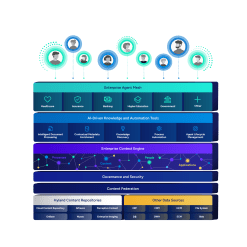As technology advances at a rapid pace, industries are realizing the need for an IT modernization strategy, which involves upgrading IT systems to remain competitive, agile and resilient to new business challenges. Gartner predicts worldwide IT spending to reach $5 trillion in 2024, an increase of 6.8% from 2023.
There’s a misconception that IT upgrades mean investing in the latest, fanciest gadgets on the market. But it's actually more important to consider the purpose and outcomes of IT modernization, which should point towards enhancing performance, improving efficiency and aligning technology capabilities with current business goals.
So, what exactly is IT modernization, and how can your company best put it into practice?
What is IT modernization?
IT modernization is the process of upgrading your organization’s technology systems, processes and strategies to improve efficiency, productivity and service delivery.
Many companies built their digital foundation on first-generation content management systems, many of which no longer meet business needs due to their outdated technology and lack of compatibility with today’s fast-paced industry environment. Businesses must transition away from these systems and move toward technology solutions with modern, advanced capabilities such as cloud computing, automated workflows, data analytics and updated software platforms.
The difference between IT modernization and digital transformation
Not to be confused with digital transformation, IT modernization specifically involves existing technology infrastructure, systems, products and solutions. Focusing on upgrading these tools allows businesses to future-proof their operations, lower costs and stay ahead of the competition in an increasingly digital world.
Digital transformation is more holistic, encapsulating broader aspects of how an organization integrates digital technology to operate efficiently and deliver value. Besides updating IT systems, digital transformation involves driving innovation and reimagining company-wide business processes, employee workflows and customer experiences.
IT transformation plays a part in the wider scope of digital transformation, serving as a critical first step toward providing a strong foundation for the adoption of newer technologies and innovative strategies.
Why modernize IT?
With today’s rapid technological evolution, IT modernization is a necessity. Clients expect seamless digital experiences, and companies need to work more efficiently to meet these demands.
IT modernization can help with:
- Operational efficiency: Technology modernization reduces the need for manual labor by automating and streamlining processes, as well as facilitating smooth communication through collaborative tools. With these integrated capabilities come better data management and decision-making.
- Scalability: Modern IT infrastructures — like cloud-enabled content services — are agile, allowing companies to scale up or down based on demand, changing workloads and varying business needs without much disruption.
- Enhanced security: Modern IT systems come with advanced security measures such as data encryption, multifactor authentication and selected access tools — protecting crucial and sensitive company data against cybersecurity threats.
- Regulatory enforcement: In heavily regulated industries, modern IT systems can help meet compliance requirements through automated regulatory tracking and reporting capabilities. They can generate real-time reports and submit regulatory reports automatically, keep crucial records safe and readily accessible and provide audit trails to ensure that companies operate within legal guidelines.
- Long-term cost and time savings: Today’s contemporary IT tools require less maintenance due to built-in monitoring, diagnostic and updating systems. Cloud-supported solution maintenance often falls to the service provider, meaning that companies spend less time, money and resources fixing IT infrastructure. Modern IT technology also helps save costs associated with physical storage, energy, materials and human labor.
Examples of IT modernization
There are several approaches to technology modernization, revolving around different areas of a company’s IT infrastructure.
| Cloud migration | Companies can migrate applications, data storage and computing resources from legacy systems to cloud platforms for flexibility and cost-efficiency. |
| Application modernization | This involves migrating from on-premises systems to cloud solutions or adopting newer software and hardware. |
| Automation and AI integration | Companies are taking advantage of artificial intelligence (AI) and automation tools to streamline operations, reduce manual intervention, streamline governance and policy adherence and improve decision-making. |
| Enterprise content management (ECM) modernization | Modern ECM systems use cloud-native solutions that enable digital storage, document management, intelligent automation and integration systems for smooth data migration. |
Organizations should tailor their IT modernization strategy based on specific needs, business goals and industry trends. You should also take note of emerging technology capabilities and content services in the market that enhance efficiency.
The role of emerging technologies in IT modernization
Emerging technologies play a pivotal role in IT modernization — in fact, it’s much of the reason for companies to modernize IT.
Artificial intelligence (AI) and machine learning (ML) play an integral role in IT modernization. AI is a crucial driver for mission-critical operations, giving modern systems the ability to automate and optimize manual, rule-based tasks that might traditionally require human intervention; ML is a subset of AI that uses data algorithms to help computers learn how to make key predictions and decisions without the need for in-depth preprogramming.
Put together, AI and ML enable high-level automation to help companies streamline processes, gain data insights, improve decision making and improve retention strategies, freeing up staff time to work on strategy.
> Learn more: What’s the difference between artificial intelligence and machine learning?
With the increasing digitization of governance processes, advanced cybersecurity measures have become essential to protect systems and data from cyber threats. Technologies such as encryption tools, firewalls and access controls can be found in modern software platforms, and are crucial to help safeguard IT infrastructure and sensitive information.
Quantum computing is another up-and-coming innovation touted by McKinsey as one of the next big trends in tech. It’s a brand-new approach to computing that can perform multiple calculations at once, making them able to work at a much faster speed than technology built on classical computing systems.
This impacts IT modernization in multiple ways, including being able to process larger data sets more quickly, accelerate automation processes and provide tighter security measures.
5G technology is also a popular buzzword floating around. Essentially, it’s the latest upgrade of wireless technology (following 4G), offering significantly faster data transfers across servers and cloud platforms and supporting an extensive number of connected devices (Internet of Things) simultaneously. This facilitates smoother interoperability across organizations, enhancing large-scale data processing, automation and communication.
Creating a successful IT modernization strategy
There should be a systematic approach to planning for IT modernization, which involves evaluating existing IT infrastructure, identifying areas for improvement, selecting appropriate modernization strategies and developing a comprehensive implementation roadmap. Here are steps you can take:
1. Assessment and planning
You should first identify opportunities to modernize within their current processes. Are there any process gaps, and is there space for cloud adoption, automation or security enhancements?
Once you’ve narrowed down your opportunities, prioritize implementation based on how closely each aligns with your organization's personal business objectives, implementation feasibility, the impacts (both positive and negative) that it might have on your operations and factors like cost and time-to-value.
You can then start to develop a comprehensive modernization roadmap that outlines the sequence of initiatives, timelines and resources.
2. Stakeholder engagement
IT modernization is an organization-wide effort. Align your IT objectives with your current strategies and resources across departments, and loop in your relevant stakeholders to brief them on what would be required from them.
3. Selecting appropriate technologies
The technologies you select should align with your business objectives, considering scalability, security and cost.
This can be decided through conducting needs assessments, researching technology on the market, integration and compatibility with current systems, cost-benefit analysis and other research.
It’s also helpful to survey industry trends and emerging technologies — mainly the impact they’ve had on similar businesses, as well as how their capabilities suit your company needs and current infrastructure.
4. Implementation
While it may be tempting for businesses to want to make big changes, it's best to modernize in phases, starting out with smaller projects first and gradually scaling up.
5. Training and support
For all stakeholders involved, offer training and support to facilitate smooth transitions to new systems and processes, including new ECM solutions. This should be an ongoing effort as consistent training and updates are needed to keep processes running.
6. Continuous evaluation and adaptation
Regularly review your modernization progress, making sure your strategy can be adapted to easily respond to new technological advancements and business needs.
This insurance company transformed claims handling with ECM modernization
NJM Insurance Group had an aging legacy system that didn’t integrate with its core system, Guidewire. This led to challenges like lackluster customer service experiences.
NJM modernized its IT infrastructure with Hyland’s OnBase solution. Now, the company digitally manages 300 million documents and ingests 17 million documents annually, all while providing a self-service customer portal and achieving better customer service.
Read the case studyUpgrading your enterprise content management (ECM) platform for modern challenges
For a long time, businesses have faced challenges in updating legacy software systems due to their outdated programming, written many years ago in codes and languages that have now been deemed obsolete.
As times have changed, so has software agility. With a modern, cloud platform approach, organizations can smoothly integrate with business applications, quickly deploy solutions and easily update software with minimal intervention.
Modern enterprise content management (ECM) systems are designed for maximum adaptability. They can play a vital role in helping companies even during unpredictable situations in the following ways:
- Seamless information management: ECMs connect the dots across previously siloed databases by reading and identifying data, centralizing and managing them on a single cloud-based platform, enabling access anytime, anywhere to support remote work and enhance overall operational workflow.
- Risk mitigation: ECMs are designed to automatically detect and combat cyber threats effectively within today’s increasingly vulnerable digital landscape, with protection measures such as encryption, permissions, risk management and retention and selected access and approval processes.
- Compliance: Modern ECMs facilitate easier compliance, especially in the face of ever-evolving regulatory requirements, reducing the complexity of managing governance across a breadth of content types.
- Business agility: Businesses need to adapt quickly to changing market conditions, customer demands and internal requirements. Modern ECMs enable this by streamlining access to information — helping employees find the content they need quickly and easily — and integrating with other enterprise systems to facilitate data exchange, streamline workflows and improve cross-functional collaboration for faster response times and service delivery.
Today’s ECMs empower organizations to meet unprecedented or rapid demands, ensuring secure, compliant and streamlined data management — putting companies at the edge for growth, efficiency, top-of-market positioning and innovation.
Cleaning up legacy data and implementing modern content services technology were the top 2 most desired Information Governance projects in our recent study.
InfoGov World – Global Information Governance Survey 2021-2022, sponsored by Hyland
Deciding on the right ECM for you
IT modernization is an ongoing process vital for maintaining a competitive edge and helping businesses scale and succeed in the future.
Companies should regularly evaluate their technology modernization strategies and compare them against their business outputs, results and profits.
Because of its range of capabilities, a robust ECM platform can significantly enhance various aspects of a company’s IT processes, including operational efficiency, security, compliance measures, collaboration and communication.
The platform you select should have capabilities that reflect the current gaps and bottlenecks in your workflows and will best unify your content for better overall visibility, decision-making and efficiency. Hyland’s suite of modernized ECM platforms provides solutions to suit business needs across various industries.
You may also like:

Article
Migrating from an on-premises solution to the Hyland Cloud
Hyland’s migration structure is designed to minimize downtime and interruption to your organization's processes regardless of the complexity of your solution.

Article
Benefits of DAM in the cloud
Managing your assets in the cloud keeps you well positioned to meet the growing demands for content.

Article
How to build a successful cloud enablement strategy
If you’re feeling overwhelmed by the amount of cloud terms, jargon, solutions and more, you’re not alone.











